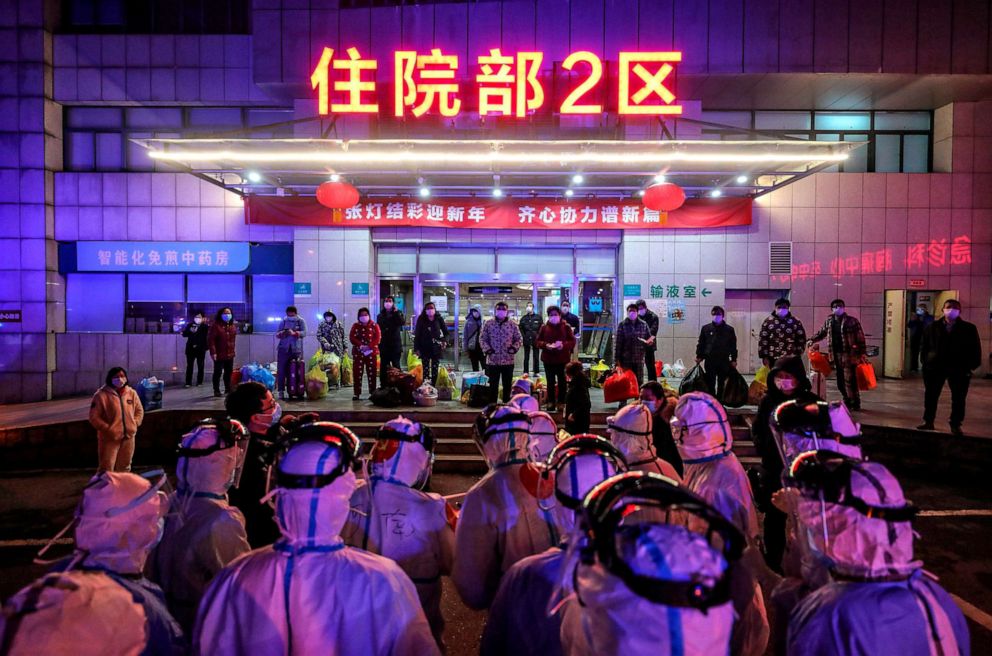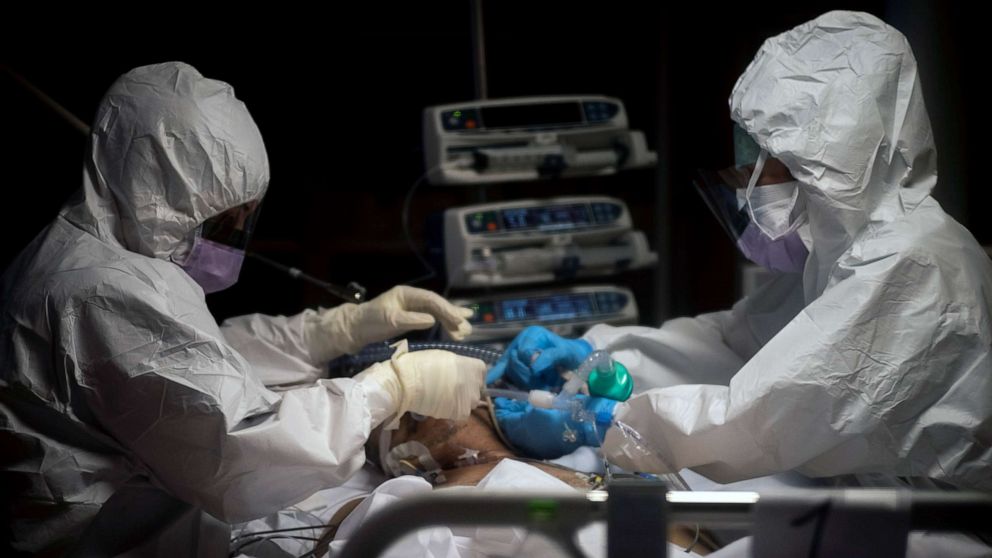As US hits 200,000 deaths, a look at how the world responded to the coronavirus pandemic
LONDON -- It has been just over six months since the World Health Organization (WHO), facing the greatest public health emergency in a century, described the spread of the novel coronavirus as a "pandemic".
Since then, life for people around the globe has changed dramatically and in some cases, beyond recognition.
Mask-wearing is now commonplace, how we socialize and educate our populations has changed, words that were once unfamiliar to us, like “contact tracing,” “lockdown” and “social distancing,” are now part of the common global vocabulary.
And above all, there is the human cost. Almost a million people have died as a result of the new disease caused by the coronavirus, COVID-19, and the countries across the world have experienced unprecedented economic damage.
The pandemic has also posed immense challenges to governments, healthcare systems and families across the globe.
As the U.S. passes 200,000 recorded COVID-19 deaths, here is a look at how we got here and what the future could bring for a world gripped by coronavirus.
The origins
Reports of the existence of a novel coronavirus started to surface early this year, when health authorities in China confirmed that dozens of people in the city of Wuhan were hospitalized with pneumonia from an unknown source. The world may not have been aware at that point, but the virus would change life for all of us as we know it.
"The confusion at the time, I think especially early January, was how this virus transmits," according to Dr. Jennifer Bouey, an epidemiologist and senior policy researcher at RAND corporation, who was in China from Jan. 10 - 14. There were suspicions the virus could create an epidemic, she said, but “the official word was not like that... I think that was the most controversial part of the story."
Even so, China’s history with the SARS outbreak of 2003 meant that the science around the understand of coronaviruses was far more advanced, she said. On Jan. 10, Chinese scientists published the virus’ genomic information, just a month after the first confirmed case. The first death was recorded a day later.
The government sparked outrage in China after allegedly covering up early reports of the novel coronavirus. Dr. Li Wenliang, a physician who was reprimanded by the local government in Wuhan for sounding the alarm, later died of COVID-19.
Despite the early confusion surrounding the virus, Bouey said that taking early action still may not have prevented a pandemic.
"The debate is whether there was earlier understanding of the virus, would it be contained in China? I highly doubt that would happen, because of the nature of the travel, globalization, and nature of this virus,” she said.
At the end of January, China took an extraordinary measure, one that at the time was drastic, but is now something billions around the world have lived through. The government moved to lock down a city of 11.8 million people, with the rest of the surrounding province, Hubei, soon to follow suit. Public transport was suspended, shops closed, and the population were instructed to stay in their homes for the foreseeable future in order to contain the spread.
Due to those incredibly strict measures, within months China reported almost no internal cases. On May 4, as the pandemic raged in the United States, China recorded only one case and zero deaths for the third week in a row.

"After that there were maybe three small clusters in Xinjiang, Beijing and one in northeast China. But that was it. I think China was probably the only country that had a community transmission, large community transmission [when transmission cannot be traced back to a single source], but got down to zero counts... I attribute that to their quite dramatic lockdown," Bouey said.
During the coming weeks and months the novel coronavirus spread to the U.S and Europe, fueled by international air travel. The first confirmed case in the U.S. was recorded in the U.S. on Jan. 21: a man from Washington state who had traveled to Wuhan.
And yet, the outbreak was not yet, according to the WHO, a “pandemic,” until March 11 – just over six months ago. When asked whether this came too late, Dr. Margaret Harris, a spokesperson for the WHO, told ABC News there are a number of misconceptions over the use of the term.
“This is something that people don't really understand,” she said. “We don't declare a 'pandemic', we declare the 'public health emergency of international concern' and we did that on the 13th of January. Now, on the 11th of March, the spread of the outbreak was so great, had gone so widely, and there was wide community transmission in more than two regions. So, it met the epidemiological definition of a pandemic. But that was about characterizing it. That was not about declaring it.”
The public health emergency means that all state parties to the IHR were warned about coronavirus’ potential, and, according to Harris, “there's been quite a difference in how seriously they took it.”
To lock down or not to lock down
By the time China had flattened the curve of the initial outbreak, soaring numbers of cases in Europe and the U.S. forced governments to take action.
“Europe and the U.S. mainly had their heads in the sand during February,” said Dr. Charles Clift, a senior consulting fellow at Chatham House’s Global Health Program, a think tank. “Ideally drastic actions relating to restricting travel and social distancing should have been taken during February to mitigate the disasters that would occur in March.
"But governments, to some extent understandably, both underestimated the risk they were facing and were reluctant to countenance the political and economic costs that would be incurred to offset a risk judged in February by many (e.g. the UK) to be only moderate.”
The world’s eyes soon turned to Italy, which overtook China’s death toll in March. Exponentially rising cases and deaths led to fears that other health systems could be overwhelmed. With scenes from the ground showing stretched intensive care units, drastic social distancing measures and a rising body count, governments began to look to Italy as where they might end up without taking serious action.
The situation in Italy were “front and center of people’s minds” in that stage of the pandemic, according to Sarah Reed, an expert in the U.K.’s National Health Service senior fellow at the Nuffield Trust, an independent British think tank.

"I think it's probably fair to say that when there were still so many unknowns about how this would play out, we were looking to countries that were further ahead than us," she told ABC News. “We saw places like Italy where hospitals were overwhelmed and that became a real clear focus, how do we prevent that from happening here.”
Healthcare systems across the globe took a remarkably similar path to cope with the potential strain, even those with different levels of sophistication.
“We saw lots of healthcare systems do things like rapidly recruiting inactive personnel and staff, moving staff into new roles, into acute care settings, countries building field hospitals to take on an increased demand, countries almost universally move more appointments online. I think that goes to show that this was a challenge for even the most prepared health systems to be able to do that," Reed said.
But while the likes of South Korea, Japan and Taiwan favored a test and trace approach, lockdown became the preferred method for preventing the spread of coronavirus for the majority of governments in Europe and parts of the U.S. The most striking example came in India, where, on March 24, a “total ban” on 1.3 billion people leaving their homes was announced by Prime Minister Narendra Modi.
The WHO itself never directly advocated a policy of lockdown, according to Harris, and instead encouraged governments to ramp up their testing capacity and enforce social distancing measures.
“It's certainly interesting in that, when Wuhan did it, well, we were like, wow, you know, you'd you have to have a society that's very accepting of stringent measures to be able to do that successfully,” she said. “And yet countries that were culturally, socially very, very different from Wuhan did it, and did it successfully.”
Even so, a series of grim and all too familiar milestones followed. The first COVID 19 death was reported in the U.S. at the end of February, and three months later the death toll surpassed 100,000. In April, worldwide cases surpassed 1 million, a tenfold increase in cases over the previous month. It took less than two weeks for that number to double. Now, the scale of the novel coronavirus’ reach is almost beyond comprehension, with over 27 million recorded cases and around 900,000 deaths worldwide, according to data compiled by Johns Hopkins University. The U.S. remains the worst hit country, with over 196,000 deaths and 6.6 million cases, according to Johns Hopkins University.
Particularly devastating in the West was the novel coronavirus’ toll on nursing homes and assisted living facilities. In May, the European Center for Disease Prevention and Control (ECDC) analysis found that the percentage of care home deaths in Europe out of death tolls varied from Germany, with 37%, to Spain and France, with 66%.
Last month, an ABC News analysis of public health data found thatdeaths in nursing homes have persisted even as the total of COVID deaths was declining, making up around 40% of virus related deaths.
In addition to how “seriously” countries took the early declarations of the WHO, countries’ “epidemic memory,” -- the idea that countries that have experienced outbreaks of SARS and MERS revamped their epidemic preparedness for future outbreaks -- particularly in Asia where there are lower numbers of deaths than the U.S. and Europe, has played a role, according to Harris. In that sense, Africa has also stood out, she said, even where there have been “very large outbreaks.”
“One of the theories about why they seem to have done better than many of the more developed countries or more developed areas is that they, too, have very strong public health infrastructure,” she said. "They understand infectious disease outbreaks. They have very fresh memories of what infectious disease outbreaks can do and they take it seriously.”
At one point in April, according to an Agence France-Press database, over 3.9 billion people – around half the global population -- were under some kind of lockdown.
One notable exception, however, was Sweden. While the Scandinavian country banned public gatherings of over 50, they chose to keep bars, clubs and restaurants open throughout the pandemic. Their strategy has received both international praise and criticism. With 5,838 deaths, the country has had a far higher death toll than its Scandinavian neighbors, but over the past two weeks has only had 0.1 COVID-19 deaths per 100,000 of the population, according to the ECDC.

A second wave?
In 12 of the 20 currently most affected countries, the number of daily confirmed cases is rising, according to a rolling two-week average compiled by Johns Hopkins University. Notable in that group is India, the world’s largest democracy, which was also the worst hit country during the Spanish Flu pandemic 100 years ago. Since moving to lift its lockdown cases have risen exponentially, recently surpassing Brazil as the second most affected country with over 5 million cases. Experts now fear India is on its way to becoming the worst effected country, with schools and society now set to reopen.
This week, the WHO recorded the single highest daily jump in cases, and governments have warned repeatedly of the risks of a “second wave,” and a return to the early months of the pandemic. That framing, according to Harris, is not necessarily helpful.


In the U.S. and across the world, societies have eased their lockdowns – encouraging their populations to return to work and go back to school. In Europe, cases have been steadily rising as society has opened up. While that has not necessarily translated to the same numbers of deaths as in the early stages of the pandemic, according to Harris, weighing a balanced approach, having learned the lessons of the past six months, will be crucial in the coming winter.
"We are just saying manage a society in a way that prevents a virus like this destroying your most productive, cutting the heart out of your community," Harris said ."But keep on with your activities in a safe way. It's not easy. That takes a lot of negotiation. That takes a lot of understanding. That takes a lot of working and a lot of commitment to change. But it can be done.”
Very few diseases have been totally eradicated with a vaccine, Harris said, and while a safe and effective vaccine would bring transmission down, that "alone isn't going to stop it.”
Aside from coronavirus, the WHO remain “very concerned” about the restrictions on access to healthcare, particularly for treating non-communicable illnesses like cancer, Harris said. Humanitarian agencies have also warned that rising child malnutrition rates could lead to 12,000 excess deaths per month due to “wasting” (a severe form of malnutrition) this year. “Indeed, much of what we've been saying and one of the reasons for keeping transmission down as low as you can is so that the health system isn't only dealing with COVID,” she said.
“Quite a few people like yourself are asking "what's changed" since we characterized it as a pandemic,” Harris said. “And I would say exactly our knowledge. We know so much more about this virus.”
Armed with that knowledge, the next six months may look very different, with the experience and lessons learned from how to deal with the biggest global health emergency in 100 years. Even so, the long-term effects of the past six months have not yet been felt, and how successfully the world responded may be impossible to judge.
“The long term impact of the pandemic will be profound, economically, socially and politically,” according to Clift. “These long term effects will outweigh the immediate costs in terms of health – it may not be possible to say which of the paths followed in the early stages of the pandemic were best in minimizing the costs to health and livelihoods until 2030, if then.”




